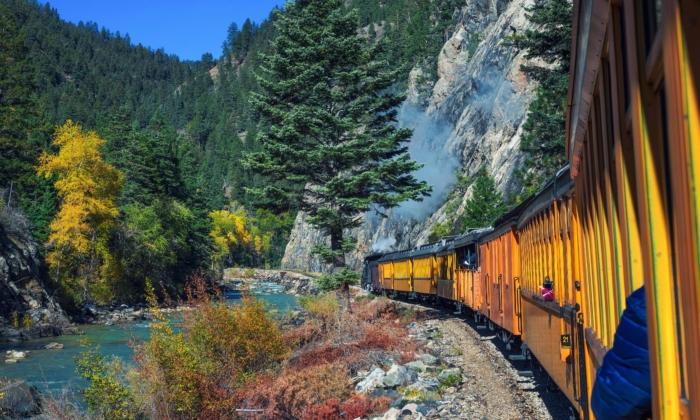Diners enjoy a gourmet meal in a graceful setting of polished mahogany walls and gleaming crystal chandeliers. Nurses are on hand to care for infants so their mothers can get some rest. People savor strawberries and other fresh fruit picked for their enjoyment.
These were among many perks of train travel during the early 20th century. That was the heyday of the iron horse, when puffing steam engines helped to develop the United States’ East, open its West, and support a nationwide Industrial Revolution.
While those railroad glory days have passed, train buffs and others can recapture some of their allure today. Reminiscent rail journeys throughout the country offer opportunities to respond to the familiar “all aboard” cry and relive rolling chapters of America’s past.
Whatever your interests—from history to breathtaking scenery, visiting museums, or learning to operate a steam locomotive—opportunities are available for you to pursue them.
Not surprisingly, enjoying views of magnificent scenery is a benefit of many train trips. The Grand Canyon is recognized as one of the Seven Natural Wonders of the World, and the railway that carries passengers to its South Rim passes through changing Arizona landscapes of prairie, ponderosa pine groves, and high desert.
On its run between Chicago and Los Angeles, Amtrak’s Southwest Chief crosses the mighty Mississippi River before winding through wheat fields and ranches, deserts and mountains, and canyon passages only a few feet wider than the train itself.
As they roll through 46 of the contiguous U.S. states, Amtrak’s passenger cars provide an introduction to an inviting array of landscapes. For the California Zephyr (Chicago to San Francisco), these include picture-perfect views of fertile farmlands, soaring Rocky Mountains, and the largest canyon along the Upper Colorado River. On its southern route between Chicago and Los Angeles the Texas Eagle passes the Ozark Mountains, historic towns, and tiny train depots that hint at how the West was won by rail.
Other pages of railroad lore are turned at museums that await exploration along some routes. Collections at the Nevada Northern Railway complex in Ely, which are housed is more than 70 buildings, include original steam locomotives, historic passenger and freight cars, and the oldest operating tank and coal-fired steam crane on any American railroad.

Historical touches from railroading’s past are by no means confined to musty museums. The Broadmoor Manitou & Pikes Peak Cog Railway dates back to 1891. Another claim to fame is that it offers the highest rail ride in the country, reaching a 14,115-foot-tall mountaintop.
Almost a decade earlier, the Durango & Silverton Narrow Gauge Railroad began chugging through the San Juan Mountains in Colorado, hauling silver and gold from the appropriately named town of Silverton. That community boomed until the early 20th century, and its status as a designated National Historic Landmark District recalls that heady time.
The Durango & Silverton line also is distinctive because, as its name attests, it is one of the remaining narrow-gauge railroads in the country. Beginning in the 1870s, miles of track ranging from two to three feet wide were built as a cost-effective alternative to the wider standard in more frequent use. Within a decade, most of those rails had been replaced, but some remain in operation as reminders of that experiment.
Another reminder is the East Broad Top Railroad, a 150-year-old railway that runs in central Pennsylvania. Its lovingly restored steam engine pulls open-air cars and a vintage caboose through a setting of rolling hills and farmlands.
Cog railways provide a ride-the-rails experience very different from traditional train travel. They’re fitted with one or more cog wheels, or gears, that cling to the track, allowing the cars to climb much steeper grades than they otherwise could.
The Mount Washington Cog Railway in New Hampshire is the second steepest in the world, after one in Switzerland. It ascends an average grade of 25 percent and, in one stretch, climbs a challenging 37 percent incline.

If climbing a mountain as a passenger aboard a chugging train or watching stunning scenery from an open railroad car doesn’t give you your funicular fix, how about taking the throttle of a heritage engine and driving the locomotive yourself? That hands-on “Be an Engineer” experience awaits visitors to the Nevada Northern Railway.
The adventure begins by studying the same safety training materials as regular crews and passing a basic test. Then guest engineers head to the century-old engine house to help prepare the locomotive and learn how to operate it. Climbing into the operator’s seat, they follow instructions given by their experienced mentor to move the engine onto the original NNRY tracks. Put your hand on the throttle, sound the whistle, and head for the mines from which the railroad used to transport ore.
This opportunity to be an engineer is but one among many around the country available to those enchanted by the clickety-clack of train wheels. A search for rides on the www.onlyinyourstate.com website is one source for finding them.
When You Go
TheTrain.com
Amtrak.com
NNRY.com
CogRailway.com
DurangoTrain.com
EastBroadTop.com





